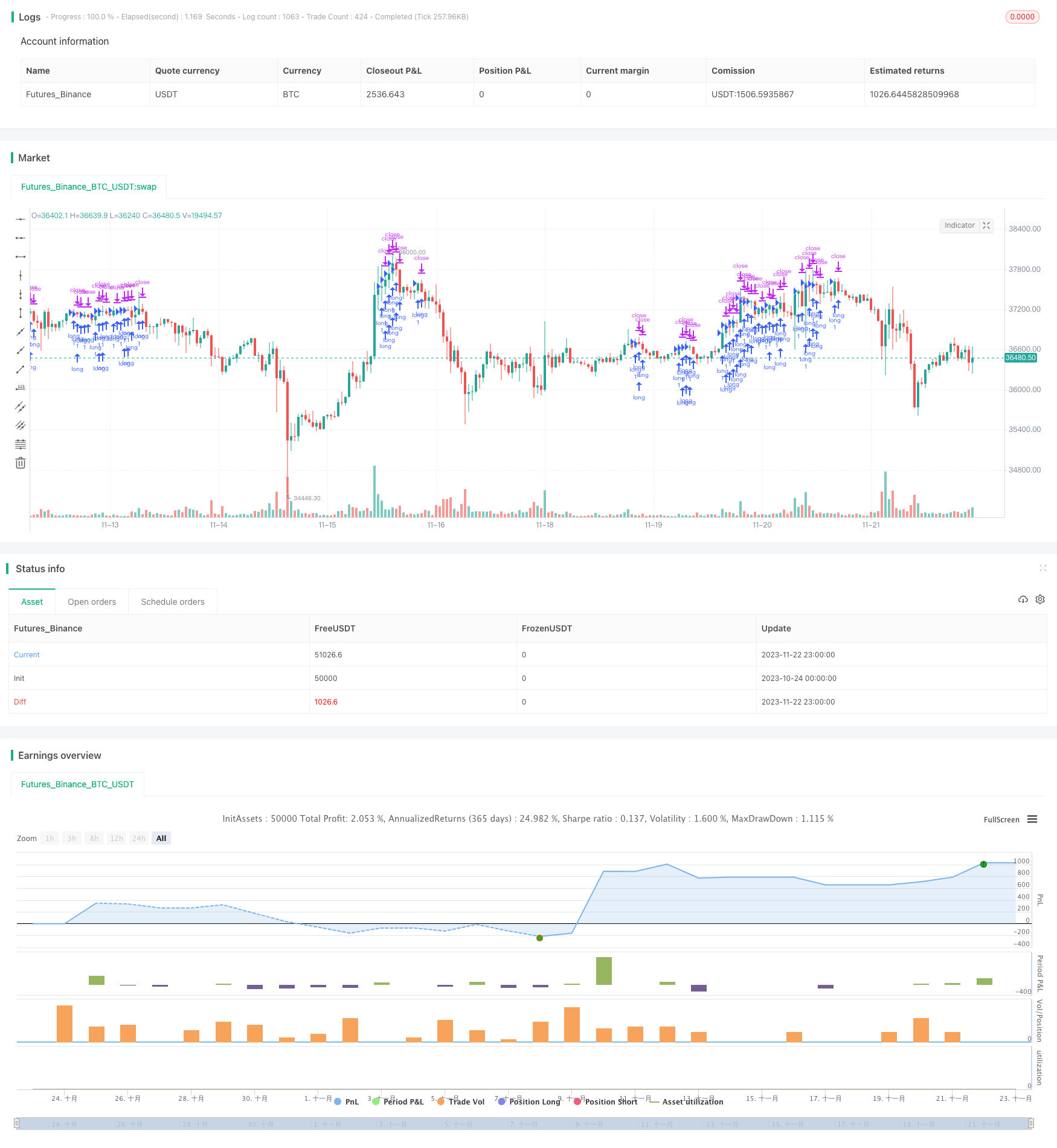
概述
该策略是一个基于4个不同周期的SMMA(平滑移动平均线)以及1个EMA指标的移动平均系统。它结合了多个证券技术分析工具,通过趋势判断形成交易策略。该策略主要适用于高杠杆账户的EURUSD 15分钟债券进行日内交易。
策略原理
该策略使用4个不同参数的SMMA(3,6,9,50)以及1个EMA(200)构建多层次的移动平均系统。SMMA指标可以有效过滤市场噪音,判断趋势方向。EMA指标检测长期趋势。具体交易逻辑是:
当短周期移动平均线(例如3周期SMMA)上穿较长周期移动平均线(例如200周期EMA)时产生买入信号。当短周期移动平均线下穿较长周期移动平均线时产生卖出信号。这样通过判断多个移动平均线的排列关系确定趋势方向。
此外,策略还设定了止盈止损点以控制风险。
优势分析
该策略具有以下优势:
多层次移动平均线结构可以有效判断趋势方向,减少假信号。
SMMA指标有效过滤了市场噪音,EMA指标检测长线趋势。
适合高杠杆账户,可以放大交易盈利。
设定了止盈止损点,可以有效控制风险。
优化了交易品种(EURUSD)和周期(15分钟),使其更具优势。
风险分析
该策略也存在以下风险:
大量使用移动平均线,可能错过短期反转机会。
高杠杆放大损失的同时也放大了盈利。
移动平均线产生信号时,短期行情可能已经发生反转。
EURUSD汇率可能产生剧烈波动,带来更大风险。
针对这些风险,可以适当调整杠杆倍数,优化移动平均线的参数,引入其他指标判断行情反转等进行优化。
优化方向
该策略的主要优化方向有:
评估不同品种和周期的表现,选择最优参数。
测试不同的参数组合和数量的移动平均线。
增加成交量或波动率指标判断短期反转点。
增加止盈止损幅度的动态调整。
加入ENU指标判断反转点。
通过多方面测试和优化,可以大幅提高策略的稳定性和盈利能力。
总结
该移动平均线策略整合了均线指标的优势,形成稳健的趋势判断系统。它优化了交易品种和周期,非常适合高杠杆日内交易。通过参数调整和优化测试,该策略可以成为高效可靠的算法交易策略。
/*backtest
start: 2023-10-24 00:00:00
end: 2023-11-23 00:00:00
period: 1h
basePeriod: 15m
exchanges: [{"eid":"Futures_Binance","currency":"BTC_USDT"}]
*/
// This source code is subject to the terms of the Mozilla Public License 2.0 at https://mozilla.org/MPL/2.0/
// © SoftKill21
//@version=4
strategy("Money maker EURUSD 15min" )
fromDay = input(defval = 1, title = "From Day", minval = 1, maxval = 31)
fromMonth = input(defval = 1, title = "From Month", minval = 1, maxval = 12)
fromYear = input(defval = 2000, title = "From Year", minval = 1970)
// To Date Inputs
toDay = input(defval = 1, title = "To Day", minval = 1, maxval = 31)
toMonth = input(defval = 8, title = "To Month", minval = 1, maxval = 12)
toYear = input(defval = 2021, title = "To Year", minval = 1970)
startDate = timestamp(fromYear, fromMonth, fromDay, 00, 00)
finishDate = timestamp(toYear, toMonth, toDay, 00, 00)
len = input(3, minval=1, title="Length")
src = input(hl2, title="Source")
smma = 0.0
sma1 = sma(src, len)
smma := na(smma[1]) ? sma1 : (smma[1] * (len - 1) + src) / len
len2 = input(6, minval=1, title="Length")
src2 = input(hl2, title="Source")
smma2 = 0.0
sma2 = sma(src2, len2)
smma2 := na(smma2[1]) ? sma2 : (smma2[1] * (len2 - 1) + src2) / len2
len3 = input(9, minval=1, title="Length")
src3 = input(hl2, title="Source")
smma3 = 0.0
sma3 = sma(src3, len3)
smma3 := na(smma3[1]) ? sma3 : (smma3[1] * (len3 - 1) + src3) / len3
len4 = input(50, minval=1, title="Length")
src4 = input(close, title="Source")
smma4 = 0.0
sma4 = sma(src4, len4)
smma4 := na(smma4[1]) ? sma4 : (smma4[1] * (len4 - 1) + src4) / len4
len5 = input(200, minval=1, title="Length")
src5 = input(close, title="Source")
out5 = ema(src5, len5)
timeinrange(res, sess) => time(res, sess) != 0
london=timeinrange(timeframe.period, "0300-1045")
londonEntry=timeinrange(timeframe.period, "0300-0845")
extraEntry =timeinrange(timeframe.period, "0745-1030")
time_cond = true
//time_cond2 = time >= startDate and time <= finishDate and extraEntry
//
longCond = close > out5 and close > smma4 and close > smma3 and close > smma2 and close > smma and smma > smma2 and smma2>smma3 and smma3>smma4 and smma4>out5 and time_cond
shortCond = close < out5 and close < smma4 and close < smma3 and close < smma2 and close < smma and smma < smma2 and smma2<smma3 and smma3<smma4 and smma4<out5 and time_cond
//longCond = close > out5 and close > smma4 and close > smma3 and close > smma2 and close > smma and smma > smma2 and smma2>smma3 and smma3>smma4 and smma4>out5 and time_cond2
//shortCond = close < out5 and close < smma4 and close < smma3 and close < smma2 and close < smma and smma < smma2 and smma2<smma3 and smma3<smma4 and smma4<out5 and time_cond2
//longCond2 = crossover(close,out5) and crossover(close,smma4) and crossover(close,smma3) and crossover(close,smma2) and crossover(close,smma) and time_cond
//shortCond2 = crossunder(close,out5) and crossunder(close,smma4) and crossunder(close,smma3) and crossunder(close,smma2) and crossunder(close,smma) and time_cond
tp=input(300,title="tp")
sl=input(300,title="sl")
strategy.initial_capital = 50000
//MONEY MANAGEMENT--------------------------------------------------------------
balance = strategy.netprofit + strategy.initial_capital //current balance
floating = strategy.openprofit //floating profit/loss
risk = input(1,type=input.float,title="Risk %")/100 //risk % per trade
//Calculate the size of the next trade
temp01 = balance * risk //Risk in USD
temp02 = temp01/sl //Risk in lots
temp03 = temp02*100000 //Convert to contracts
size = temp03 - temp03%1000 //Normalize to 1000s (Trade size)
if(size < 1000)
size := 1000 //Set min. lot size
dataL = (close-out5)*100000
dataS = (out5-close)*100000
minDistanceL = (smma4 - out5)*100000
minDistanceS= (out5 - smma4)*100000
strategy.entry("long",1,1,when=longCond )
strategy.exit("closelong","long", profit=tp,loss=sl)
strategy.entry("short",0,1,when=shortCond )
strategy.exit("closeshort","short", profit=tp,loss=sl)
strategy.close_all(when = not london, comment="london finish")
//strategy.close_all(when = not extraEntry, comment="london finish")
// maxEntry=input(2,title="max entries")
// strategy.risk.max_intraday_filled_orders(maxEntry)